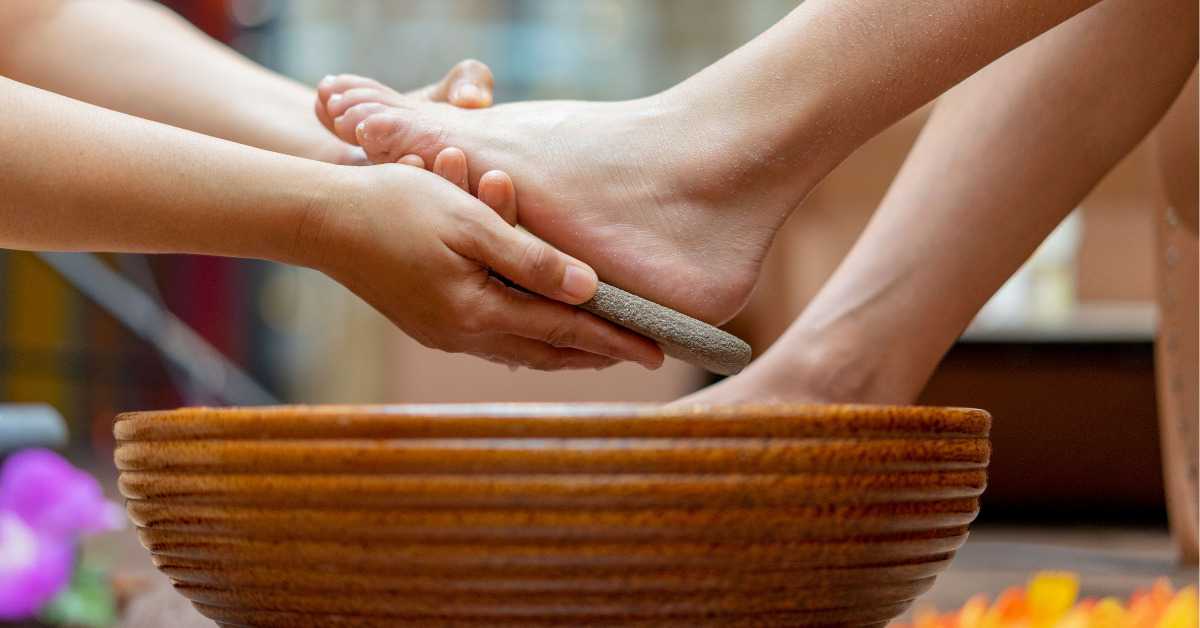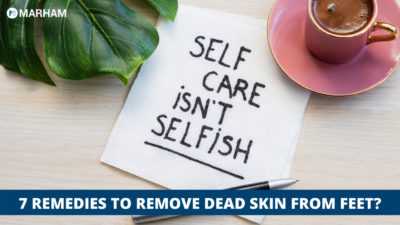It’s normal to have dead or peeling skin on the feet, but it can be disgusting. While skin cell death is a natural process, there’s no reason to let dead cells accumulate on your skin and detract from its radiance. To learn how to remove dead skin from feet, keep reading and following the steps outlined in the blog!
What Causes Dead Skin To Accumulate?
A variety of factors that contribute to the accumulation of dead skin are:
- Aging- The accumulation of dead skin is exacerbated by aging. Because our skin cells don’t regenerate as quickly as they used to as we get older, it’s natural for dead cells to accumulate.
- Dry Skin- Skin cells die faster than usual when dry skin. This means that when you have dry skin, your body’s surface is likely covered in dead skin. Skin conditions such as eczema and Psoriasis make it easier for dead cells to accumulate on the surface of your skin.
- Not Exfoliating- Another major contributor to dead skin accumulation is not exfoliating. According to the American Academy of Dermatology, exfoliating scrubs remove all of the dead skin cells. So skipping this important skincare step ends up in a disaster (also known as dull skin).
- Environmental Factors- The amount of dead skin that accumulates on your body is influenced by the environment. This involves everything from your local climate to the current season and the duration of time you spend in the sun.


Remedies to Treat Dead Skin from Feet
1- Foot scrub
You can make a foot scrub by combining two tablespoons of sea salt with equal parts baby oil and lemon juice. Apply it directly to the foot and gently rub it with your palm or simply use a sponge or foot scrub brush to remove dead skin. And after each use, thoroughly rinse the scrub with warm water. If you still have any concerns on how to remove dead skin from feet, check with a dermatologist.
2- Oatmeal scrub
To remove the dead skin, you can make an exfoliator with oatmeal. Make a paste out of equal parts oatmeal, milk, and rose water to make the scrub. To use:
- Apply the homemade scrub to the feet and let it sit for almost 20 to 30 minutes.
- Use a foot brush for exfoliating your feet.
- Rinse using cold water and let the feet dry.
- Apply a foot cream.
Do this treatment on alternate days for the best results.
3- Pumice stone
Pumice stone is the natural lava stone that helps remove calluses and dead skin from your feet.
To use:
- Dip the pumice stone in warm water for a few minutes before using it.
- Move the stone around the foot gently, either in a sideways or circular motion. To promote a healthy cell turnover, concentrate on removing only the top layer of skin rather than the entire dead skin area.
- Apply oil or lotion afterward to soften your feet.
Never use this stone on the injured or sore areas.
4- Paraffin wax
You can do a paraffin wax remedy at home by using an at-home paraffin wax bath or melting the wax in the saucepan and then soaking your feet in it. When using paraffin wax, be very careful and check the temperature of wax using a candy thermometer.
You have to dip your feet in the wax numerous times during this treatment. Wrap your feet in plastic after applying several players of wax. Remove the wax once it has hardened. And the dead skin on the feet is removed along with the wax. You can also read 10 tips for the best skincare in winter.
Do not use a paraffin wax if:
- You’ve poor blood circulation
- You have got a rash or an open sore on the feet
- You have lost sensation in the feet, like from diabetic neuropathy


5- Epsom salt soak or scrub
Epsom salt is the crystal form of magnesium sulfate. Epsom salt dissolved in water could be used to dip your feet. It can help in exfoliating and smoothing your dry, cracked feet. This, in turn, could assist in the removal of dead skin. To use:
- Epsom salt soaks made by adding 1/2 cup of salt to a footbath or 1 cup of salt to a bathtub full of warm water.
- Relax and dip your feet for almost 20 minutes.
- Use the pumice stone or a foot brush afterward to remove dry skin.
You can make an Epsom salt scrub for your feet by mixing Epsom salt with a few drops of bath or olive oil in your hand or on a sponge. Apply it to your feet. Gently rub it over wet skin to remove dead skin, soften it, and exfoliate it. Rinse off with water.
6- Baby foot peel
A popular one-hour at-home treatment to exfoliate dead skin and smooth your feet is the Baby Foot Peel.
Follow the package’s instructions for use:
- After wetting the feet, you will secure the “plastic booties” to the feet with adhesive tape.
- Leave the booties on for almost one hour.
- Remove the booties and wash the feet gently using soap and water.
This medication hasn’t been studied scientifically but has a large following on the internet. Moreover, if you really want to have good skin, read the tips for no dry hands and feet this winter.
7- Vinegar soak
Vinegar soaks can soothe your feet while removing dead, dry, or damaged skin. Use cool water instead of hot water to make the soak, as hot water will dry out the skin even more. Generally, one part vinegar to two parts water is recommended for the soak. To begin, dip your feet for 5 to 10 minutes. If desired, use a pumice stone to remove the dry or loose skin after the soak, following the directions above. Put on socks after soaking in vinegar. Apply petroleum jelly, coconut oil, or moisturizer to seal in moisture. This treatment should only be used a few times each week because it can cause the skin to become even drier.
Use with Caution
Baking soda soak
To eliminate dead skin from the foot, baking soda is a common at-home therapy. However, baking soda can irritate the skin, creating redness, and leading it to dry out even more. So, Before attempting a new treatment, see your skin specialist.
To use:
- Add only 2-3 teaspoons in a full footbath of warm water for about 10-20 minutes if you use baking soda.
- After your soak, gently remove dead skin with a pumice stone or a foot brush, as described previously. After that, use a lot of moisturizers.
- If the feet become red or irritated during soaking, remove them from the solution as soon as possible.


Lemon water soak
Dead skin cells could be removed from the feet using the acidity in lemons. They can disrupt the skin’s natural pH balance, resulting in increased dryness and dead skin.
Don’t use lemon if you:
- have any open sores or cuts on your foot
- have sensitive skin
- experience any irritation and redness
If you plan to use this method:
- Prepare a footbath using warm water.
- Squeeze in lemon juice from one lemon. You may also leave pieces of the lemon peel in water.
- Dip your feet for almost 15 minutes.
- Use a foot brush to scrub the dead skin off your feet.
- Wash and dry the feet. Apply coconut oil or a moisturizer, if desired.
Razor or scraper
A callous or dead skin on your foot should only be removed with a razor or scraper by a podiatrist or other skilled medical expert. Avoid using razors or scrapers on your feet when you’re at home. This could harm your foot or cause you to develop another medical problem. For example, if you cut yourself, you run the risk of contracting a bacterial infection. If you’re having trouble eliminating dry or dead skin, talk to your doctor about other options for prescription or at-home treatments.
Preventing Dead Skin on Feet
Following are the few basic things you can do to keep dead skin from accumulating on your foot:
- Make sure you use a soap that doesn’t irritate your skin and rinse it thoroughly after washing.
- Avoid lotions or other personal hygiene products containing alcohol.
- Exfoliate your feet regularly.
- Apply a moisturizer to the feet every day.
- Drink plenty of water.
- Get a pedicure treatment occasionally.
- Use a foot peel now and then.
On a Final Note
In most cases, dead skin isn’t a problem, and it’s usually possible to get rid of it yourself at home. Contact your doctor or podiatrist right away if you have dead skin, calluses, broken skin, sores, or rashes that don’t go away on their own or with home cures. You can consult with a dermatologist via Marham.pk.
Book an appointment now, to answer all your queries. You can book an appointment with the top dermatologists in Pakistan through Marham by calling at Marham helpline: 0311-1222398 or by online booking facility through the website or Marham mobile app.
Can’t Find The App?
Android Users:
https://play.google.com/store/apps/details?id=controllers.marham.marhammed&hl=en
Drop a review for us at Playstore if you’ve had a good experience!
iPhone Users:
https://apps.apple.com/pk/app/marham-find-a-doctor/id1095243102
Stay Home. Stay Safe!
FAQs
1- Is exfoliate and scrub the same?
Scrubs and exfoliators are different in that scrubs use tiny exfoliating particles, while exfoliators use mechanical or chemical agents to remove dead skin cells from the surface of the skin.
2- Why does dead skin build-up on the face?
The main reason for this buildup is not exfoliating your face regularly.
3- How can I check my skin type at home?
Pat a blotting paper gently on your face in different areas. Check the amount of oil visible on the sheet by holding it up to the light. You probably have dry skin if the sheet picked up little to no oil. And your skin type is a combination if the blotting sheet shows oil on your forehead and nose.

